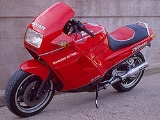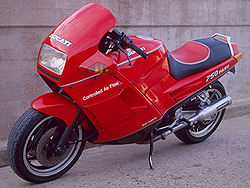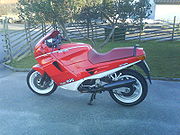
Ducati Paso
Encyclopedia

Renzo Pasolini
Renzo Pasolini , nicknamed "Paso", was a popular Italian Grand Prix motorcycle road racer in the 1960s.His unpredictable and unrehearsed racing style made him a crowd favourite...
, nicknamed "Paso", who died on 20 May 1973 in an accident at the Monza
Autodromo Nazionale Monza
The Autodromo Nazionale Monza is a race track located near the town of Monza, north of Milan, in Italy. The circuit's biggest event is the Formula One Italian Grand Prix, which has been hosted there since the sport's inception....
race track during the Grand Prix of Italy.
Background
The CagivaCagiva
Cagiva is an Italian motorcycle manufacturer. It was founded in 1950 by Giovanni Castiglioni in Varese, originally producing small metal components. It went into the motorcycle industry in 1978. The name is a portmanteau derived from the founder and the founding location, i.e. CAstiglioni GIovanni...
(from CAstiglioni GIovanni VArese) company, founded by the Castiglioni brothers, needed an engine - while Ducati, who had just been released from a difficult past of statutory public management (IRI), needed revenue.
Over a series of Italian style meetings/lunches in 1984, they agreed a deal for Ducati to supply engines to Cagiva - and then go out of the business of producing motorcycles. However, the Castiglioni brothers of Cagiva were eventually offered a deal to buy Ducati, subject to the Ducati name living on as an actual motorcycle product. On closure of the deal, Ducati engines were instantly installed in a number of Cagiva
Cagiva
Cagiva is an Italian motorcycle manufacturer. It was founded in 1950 by Giovanni Castiglioni in Varese, originally producing small metal components. It went into the motorcycle industry in 1978. The name is a portmanteau derived from the founder and the founding location, i.e. CAstiglioni GIovanni...
bikes, which included the Alazzurra and the Elephant enduro bike.
At the time of the takeover, due to its financial difficulties Ducati was in a state of suspended animation with regards to engineering development. By that time, the classic bevel drive V-twin
V-twin
A V-twin engine is a two-cylinder internal combustion engine where the cylinders are arranged in a V configuration.- Crankshaft configuration :Most V-twin engines have a single crankpin, which is shared by both connecting rods...
, which was old and expensive to produce, had been replaced by the belt-drive Pantah
Ducati Pantah
The Pantah was the first of the belt-driven camshaft Ducati motors, the first generation of the current Ducati V twins. First shown December 1979, it came on the market as the 1980 500SL and the last of the line 650SL was sold in 1986...
, designed by Fabio Taglioni
Fabio Taglioni
Fabio Taglioni was an Italian engineer.Born in Lugo di Romagna, he was chief designer and technical director of Ducati from 1954 until 1989. His desmodromic L-twin design is still used in all current Ducati motorcycle engines...
. The Pantah was already known to be a strong and capable engine, and known to deliver in the Ducati 750 F1.
The Pantah engine is equipped with desmodromic valve
Desmodromic valve
A desmodromic valve is a reciprocating engine valve that is positively closed by a cam and leverage system, rather than by a more conventional spring...
s and has been constantly developed up to the present day. And around it they wanted a Ducati motorcycle unlike any other, that showed the world both Ducati's capabilities, and where it would go in the future.
The design challenge
The challenge consisted in constructing a bike with innovative technical characteristics and image to fight the intense Japanese competition. To undertake the ambitious objective Ducati hired Massimo TamburiniMassimo Tamburini
Massimo Tamburini is an Italian motorcycle designer for motorcycle companies including: Cagiva, Ducati, MV Agusta; and Bimota, which he founded, together with Bianchi and Morri ....
, co-founder of Bimota
Bimota
Bimota is a small, Italian manufacturer of custom and production motorcycles. It was founded in 1973 in Rimini, Italy by Bianchi, Morri and Tamburini. The company name is a portmanteau derived from the first two letters of each of the three founders' surnames, i.e...
. Tamburini would go on to design the Ducati 916
Ducati 916
The Ducati 916 is an Italian sports motorcycle manufactured by Ducati from 1994 to 1998. In contrast to Japanese inline four-cylinder competitors of the time, its V-twin engine produced less outright power, but a more even torque spread...
and MV Agusta F4 series
MV Agusta F4 series
The MV Agusta F4 was the motorcycle that launched the resurrection of MV Agusta in 1998. The F4 was created by famous motorcycle designer Massimo Tamburini at CRC , following his work on the Ducati 916...
, included in the Guggenheim Museum's The Art of the Motorcycle
The Art of the Motorcycle
The Art of the Motorcycle was an exhibition that presented 114 motorcycles chosen for their historic importance or design excellence in a display designed by Frank Gehry in the curved rotunda of the Frank Lloyd Wright-designed Solomon R. Guggenheim Museum in New York City, running for three months...
exhibition of 1988-1999, and the MV Agusta Brutale series
MV Agusta Brutale series
The Brutale series of motorcycles are manufactured by MV Agusta of Italy. Its style is classified as a naked bike and the series consists of several models powered by either 749.5 cc or 909.1 cc inline-four, dohc-engines....
.
Tamburini decided to streamline the bike and its 750cc motor in a close-fitting integral fairing that hid all mechanical parts. The bike was equipped with latest-generation technical features: square frame tubes made in chromoly steel, rear aluminium swingarm
Swingarm
A swingarm, or "swinging arm" is the main component of the rear suspension of most modern motorcycles and ATVs...
with progressive suspension, 16-inch wheels with radial tire
Radial tire
A radial tire is a particular design of automotive tire . In this design, the cord plies are arranged at 90 degrees to the direction of travel, or radially ....
s, air-and-oil cooled engine, electronic ignition and a comprehensive dashboard.
The finished design was christened the Paso 750, and debuted at the 1985 Milan Motorcycle Show. Ducati and Cagiva had hopes that the new machine would redefine sports touring motorcycling and complement their sportsbike line, especially in the American market.
Sales and development

Weber carburetor
Weber is an Italian company producing carburetors, currently owned by Magneti Marelli Powertrain S.p.A., in turn part of the Fiat Group.The company was established as...
carburetor
Carburetor
A carburetor , carburettor, or carburetter is a device that blends air and fuel for an internal combustion engine. It is sometimes shortened to carb in North America and the United Kingdom....
, which was ill-suited to a small-capacity motorcycle engine.
In 1989 the Paso 906 was introduced to replace the 750, with a six-speed gearbox, a 904 cc engine which provided 88 hp and a 220 km/h top speed. The bike still had the same automotive carburettor and unreliable electrical system, but its greatest development was the incorporation of liquid cooling
Liquid cooling
Liquid cooling may refer to:* The cooling of a liquid.* The cooling of machinery or devices by convection or circulation of coolants* Liquid Cooling and Ventilation Garment, a garment worn by astronauts.* Liquid metal cooled reactor...
. 1,802 Paso 906's were built between 1988 and 1989.
After further development, the final version of the design came in 1990 with the 907IE (Iniezione Elettronica); now without the name "Paso". The engine remained liquid-cooled and the carburetor was replaced by the most modern Weber-Marelli IAW 043 system that integrated ignition and electronic fuel injection
Fuel injection
Fuel injection is a system for admitting fuel into an internal combustion engine. It has become the primary fuel delivery system used in automotive petrol engines, having almost completely replaced carburetors in the late 1980s....
, which transformed the rideability of the bike. Power increased to 90 hp and top speed to 230 km/h. The wheels were changed to 17 inches, giving the bike more stability.
Despite these advances sales of this model remained sluggish, and when production ceased in 1992 only 2,303 907IE's had been built.

